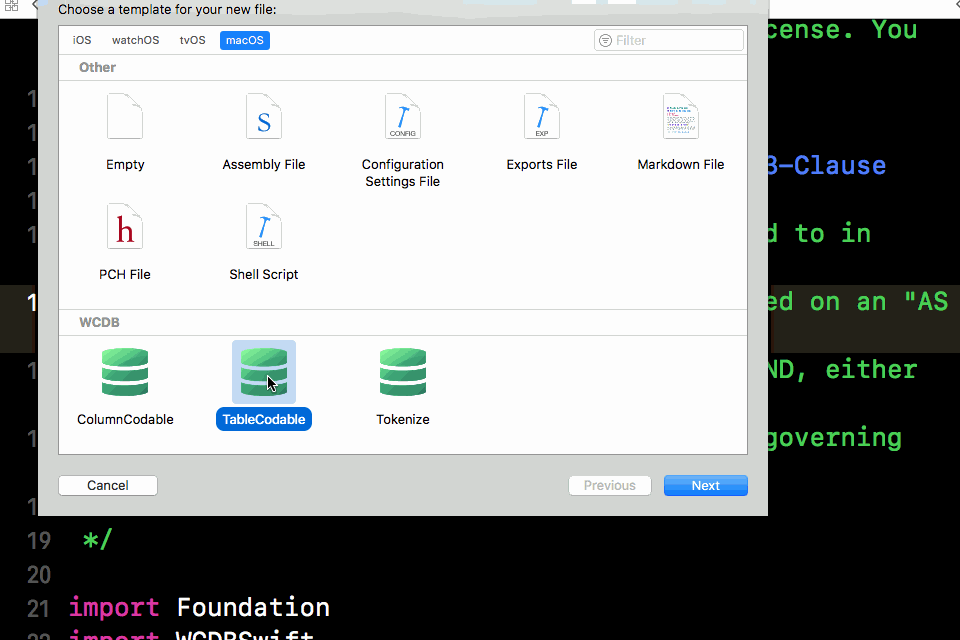-
Notifications
You must be signed in to change notification settings - Fork 1.4k
Swift 模型绑定
模型绑定(Object-relational Mapping,简称 ORM),通过对 Swift 类或结构进行绑定,形成类或结构 - 表模型、类或结构对象 - 表的映射关系,从而达到通过对象直接操作数据库的目的。
WCDB Swift 的模型绑定分为五个部分:
- 字段映射
- 字段约束
- 索引
- 表约束
- 虚拟表映射
这其中大部分是格式化的模版代码,我们在最后介绍文件模版和代码提示模版,以简化模型绑定的操作。
WCDB Swift 的字段映射基于 Swift 4.0 的 Codable 协议实现。以下是一个字段映射的示例代码:
class Sample: TableCodable {
var identifier: Int? = nil
var description: String? = nil
var offset: Int = 0
var debugDescription: String? = nil
enum CodingKeys: String, CodingTableKey {
typealias Root = Sample
static let objectRelationalMapping = TableBinding(CodingKeys.self)
case identifier = "id"
case description
case offset = "db_offset"
}
}- 在类内定义
CodingKeys的枚举类,并遵循String和CodingTableKey。 - 枚举列举每一个需要定义的字段。
- 对于变量名与表的字段名不一样的情况,可以使用别名进行映射,如
case identifier = "id" - 对于不需要写入数据库的字段,则不需要在
CodingKeys内定义,如debugDescription - 对于变量名与 SQLite 的保留关键字冲突的字段,同样可以使用别名进行映射,如
offset是 SQLite 的关键字。
与 Swift 的
Codable协议不同的是,即便是所有字段都需要绑定,这里也必须列举每一个需要绑定的字段。因为CodingKeys除了用于模型绑定,还将用于语言集成查询,我们会在后面章节中介绍。
字段映射定义完成后,调用 create(table:of:) 接口即可根据这个定义创建表。
// 以下代码等效于 SQL:CREATE TABLE IF NOT EXISTS sampleTable(id INTEGER, description TEXT, db_offset INTEGER)
try database.create(table: "sampleTable", of: Sample.self)并非所有类型的变量都支持被绑定为字段。WCDB Swift 内建了常用类型的支持,包括:
| 数据库中的类型 | 类型 |
|---|---|
| 32 位整型 |
Bool, Int, Int8, Int16, Int32, UInt, UInt8, UInt16, UInt32
|
| 64 位整型 |
Int64, UInt64, Date
|
| 浮点型 |
Float, Double
|
| 字符串类型 |
String, URL
|
| 二进制类型 |
Data, Array, Dictionary, Set
|
其中
Date以时间戳的形式存储,Array、Dictionary、Set以 JSON 的形式存储。
对于没有内建支持的类型,开发者可以手动为其添加支持。我们将在自定义字段映射类型一章进一步介绍。
字段约束是 TableEncodable 的一个可选函数,可根据需求选择实现或不实现。它用于定于针对单个字段的约束,如主键约束、非空约束、唯一约束、默认值等。
以下是一个字段约束的示例代码:
class Sample: TableCodable {
var identifier: Int? = nil
var description: String? = nil
enum CodingKeys: String, CodingTableKey {
typealias Root = Sample
case identifier
case description
static let objectRelationalMapping = TableBinding(CodingKeys.self) {
BindColumnConstraint(identifier, isPrimary: true)
BindColumnConstraint(description, isNotNull: true, defaultTo: "defaultDescription")
}
}
var isAutoIncrement: Bool = false // 用于定义是否使用自增的方式插入
var lastInsertedRowID: Int64 = 0 // 用于获取自增插入后的主键值
}字段约束通过 BindColumnConstraint 配置,可以定义每个 CodingKeys 对应的约束。BindColumnConstraint 的声明如下:
BindColumnConstraint(
_ codingKey: CodingTableKeyType,// 对应字段的枚举
isPrimary: Bool = false, // 该字段是否为主键。字段约束中只能同时存在一个主键
orderBy term: OrderTerm? = nil, // 当该字段是主键时,存储顺序是升序还是降序
isAutoIncrement: Bool = false, // 当该字段是主键时,其是否支持自增。只有整型数据可以定义为自增。
onConflict conflict: Conflict? = nil, // 当该字段是主键时,若产生冲突,应如何处理
isNotNull: Bool = false, // 该字段是否可以为空
isUnique: Bool = false, // 该字段是否可以具有唯一性
defaultTo defaultValue: ColumnDef.DefaultType? = nil // 该字段在数据库内使用什么默认值
)以上约束按需进行定义或者不定义即可。
定义完成后,同样调用 create(table:of:) 接口即可根据这个定义创建表。
// 以下代码等效于 SQL:CREATE TABLE IF NOT EXISTS sampleTable(identifier INTEGER PRIMARY KEY, description TEXT NOT NULL DEFAULT 'defaultDescription')
try database.create(table: "sampleTable", of: Sample.self)配置了 isPrimary 和isAutoIncrement的字段,支持以自增的方式进行插入数据。但仍可以通过非自增的方式插入数据。
当需要进行自增插入时,对象需设置 isAutoIncrement 参数为 true,则数据库会使用 已有数据中最大的值+1 作为主键的值。
let autoIncrementObject = Sample()
autoIncrementObject.isAutoIncrement = true
// 插入自增数据
try database.insert(objects: autoIncrementObject, intoTable: "sampleTable")
print(autoIncrementObject.lastInsertedRowID) // 输出 1
// 再次插入自增数据
try database.insert(objects: autoIncrementObject, intoTable: "sampleTable")
print(autoIncrementObject.lastInsertedRowID) // 输出 2
// 插入非自增的指定数据
let specificObject = Sample()
specificObject.identifier = 10
try database.insert(objects: specificObject, intoTable: "sampleTable")对于自增插入的数据,可以在类内定义 lastInsertedRowID 字段,并以此获取插入的值。
若类只会使用自增的方式插入,而不需要指定值的方式插入,可以在定义时直接设置
isAutoIncrement为true。如:var isAutoIncrement: Bool { return true }
索引可以通过BindIndex来配置,它用于定于针对单个或多个字段的索引,索引后的数据在能有更高的查询效率。
以下是一个定义索引的示例代码:
class Sample: TableCodable {
var identifier: Int? = nil
var description: String? = nil
var multiIndexPart1: Int = 0
var multiIndexPart2: Int = 0
enum CodingKeys: String, CodingTableKey {
typealias Root = Sample
case identifier
case description
case multiIndexPart1
case multiIndexPart2
static let objectRelationalMapping = TableBinding(CodingKeys.self) {
BindIndex(identifier, namedWith: "_uniqueIndex", isUnique: true)
BindIndex(description.asIndex(orderBy: .descending), namedWith: "_descendingIndex")
BindIndex(multiIndexPart1, multiIndexPart2.asIndex(orderBy: .ascending), namedWith: "_multiIndex")
}
}
}索引通过索引后缀与索引绑定的映射实现。
- 对于需要特别指明索引存储顺序的字段,可以通过
asIndex(orderBy:)函数指定,如description.asIndex(orderBy: .descending)。 - 对于具有唯一性的索引,可以通过
isUnique:参数指定。 - 对于由多个字段组成的联合索引,
BindIndex后面可以指定多个字段,如BindIndex(multiIndexPart1, multiIndexPart2.asIndex(orderBy: .ascending), namedWith: "_multiIndex")
完整的索引名为表名+索引后缀,如:表 "sampleTable" 的索引分别为 "sampleTable_uniqueIndex"、"sampleTable_descendingIndex" 和 "sampleTable_multiIndex"。
索引定义完成后,同样调用 create(table:of:) 接口即可根据这个定义创建表。
// 以下代码等效于 SQL:
// CREATE TABLE IF NOT EXISTS sampleTable(identifier INTEGER, description TEXT, multiIndexPart1 INTEGER, multiIndexPart2 INTEGER)
// CREATE UNIQUE INDEX IF NOT EXISTS sampleTable_uniqueIndex on sampleTable(identifier)
// CREATE INDEX IF NOT EXISTS sampleTable_descendingIndex on sampleTable(description DESC)
// CREATE INDEX IF NOT EXISTS sampleTable_multiIndex on sampleTable(multiIndexPart1, multiIndexPart2 ASC)
try database.create(table: "sampleTable", of: Sample.self)表约束可以下面这些方法来配置:
-
BindMultiPrimary: 联合主键约束 -
BindMultiUnique: 联合唯一约束 -
BindChecks: 检查约束 -
BindForeignKey: 外键约束
以下是一个表约束的示例代码:
class Sample: TableCodable {
var identifier: Int? = nil
var multiPrimaryKeyPart1: Int = 0
var multiPrimaryKeyPart2: Int = 0
var multiUniquePart1: Int = 0
var multiUniquePart2: Int = 0
enum CodingKeys: String, CodingTableKey {
typealias Root = Sample
case identifier
case multiPrimaryKeyPart1
case multiPrimaryKeyPart2
case multiUniquePart1
case multiUniquePart2
static let objectRelationalMapping = TableBinding(CodingKeys.self) {
BindMultiPrimary(multiPrimaryKeyPart1.asIndex(orderBy: .descending), multiPrimaryKeyPart2)
BindMultiUnique(multiUniquePart1, multiUniquePart2.asIndex(orderBy: .ascending))
}
}
}约束的定义方式与索引类似。定义完成后,同样调用 create(table:of:) 接口即可根据这个定义创建表。
// 以下代码等效于 SQL:
// CREATE TABLE IF NOT EXISTS sampleTable(
// identifier INTEGER,
// multiPrimaryKeyPart1 INTEGER,
// multiPrimaryKeyPart2 INTEGER,
// multiUniquePart1 INTEGER,
// multiUniquePart1 INTEGER,
// CONSTRAINT PRIMARY KEY(multiPrimaryKeyPart1 DESC, multiPrimaryKeyPart2),
// CONSTRAINT UNIQUE(multiUniquePart1, multiUniquePart2 ASC)
// )
try database.create(table: "sampleTable", of: Sample.self)虚拟表映射可以使用来BindVirtualTable来配置,它用于定于虚拟表以进行全文搜索等特性。
普通表不需要用到虚拟表映射,因此这里暂且按下不表,我们会在全文搜索一章中进行介绍。
在开发过程中,经过多个版本的迭代后,经常会出现数据库字段升级的情况,如增加新字段、删除或重命名旧字段、新增索引等等。 对于 SQLite 本身,其并不支持对字段的删除和重命名。新增加字段则需要考虑不同版本升级等情况。而这个问题通过模型绑定可以很好的解决。
纵观上述字段映射、字段约束、索引和表约束等四个部分,都是通过调用 create(table:of:) 接口使其生效的。
实际上,该接口会将 模型绑定的定义 与 表本身的结构 联系起来,并进行更新。
对于字段映射:
- 表已存在但模型绑定中未定义的字段,会被忽略。这可以用于删除字段。
- 表不存在但模型绑定中有定义的字段,会被新增到表中。这可以用于新增字段。
- 对于需要重命名的字段,可以通过别名的方式重新映射。
忽略字段并不会删除字段。对于该字段旧内容,会持续存在在表中,因此文件不会因此变小。实际上,数据库作为持续增长的二进制文件,只有将其数据导出生成另一个新的数据库,才有可能回收这个字段占用的空间。对于新插入的数据,该字段内容为空,不会对性能产生可见的影响。
对于索引,不存在的索引会被新增到数据库中。
对于数据库已存在但模型绑定中未定义的索引,
create(table:of:)接口不会自动将其删除。如果需要删除,开发者需要调用drop(index:)接口。
以下是数据库升级的一个例子:
在第一个版本中,Sample 的模型绑定定义如下,并在数据库创建了以之对应的表 sampleTable。
class Sample: TableCodable {
var identifier: Int? = nil
var description: String? = nil
var createDate: Date? = nil
enum CodingKeys: String, CodingTableKey {
typealias Root = Sample
case identifier
case description
case createDate
static let objectRelationalMapping = TableBinding(CodingKeys.self)
}
}
try database.create(table: "sampleTable", of: Sample.self)到了第二个版本,sampleTable 表进行了升级。
class Sample: TableCodable {
var identifier: Int? = nil
var content: String? = nil
var title: String? = nil
enum CodingKeys: String, CodingTableKey {
typealias Root = Sample
case identifier
case content = "description"
case title
static let objectRelationalMapping = TableBinding(CodingKeys.self) {
BindIndex(title, namedWith: "_index")
}
}
}
try database.create(table: "sampleTable", of: Sample.self)可以看到,通过修改模型绑定,并再次调用 create(table:of:)
-
description字段通过别名的特性,被重命名为了content。 - 已删除的
createDate字段会被忽略。 - 对于新增的
title会被添加到表中。 - 新增的索引
sampleTable_index会被添加到表中。
模型绑定的大部分都是格式固定的代码,因此,WCDB Swift 提供了文件模版和代码模版两种方式,以简化模型绑定操作。
文件和代码模版都在源代码的 tools/templates 目录下
- 未获取 WCDB 的 Github 仓库的开发者,可以在命令执行
curl https://raw.githubusercontent.com/Tencent/wcdb/master/tools/templates/install.sh -s | sh - 已获取 WCDB 的 Github 仓库的开发者,可以手动执行
cd path-to-your-wcdb-dir/tools/templates; sh install.sh;。
文件模版安装完成后,在 Xcode 的菜单 File -> New -> File... 中创建新文件,选择 TableCodable。
在弹出的菜单中输入文件名,并选择 Language 为 Swift 即可。

在代码文件中的任意位置,输入 TableCodableClass 后选择代码模版即可。

文件和代码模版都是以
class作为例子的,实际上struct甚至enum都可以进行模型绑定的。
- 欢迎使用 WCDB
- 基础教程
- 进阶教程
- 欢迎使用 WCDB
- 基础教程
- 进阶教程
- 欢迎使用 WCDB
- 基础教程
- 进阶教程
- 欢迎使用 WCDB
- 基础教程
- 进阶教程